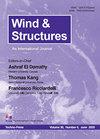列车诱导风作用下货车气动特性数值模拟
IF 1.9
4区 工程技术
Q3 CONSTRUCTION & BUILDING TECHNOLOGY
引用次数: 1
摘要
公铁两用桥的建设引起了人们对列车与道路车辆之间空气动力学干扰的关注。对相互作用机制的研究有助于计算车辆响应,以评估行驶安全性。本文将计算流体动力学(CFD)应用于研究列车诱导风作用下移动货车的气动特性。比较了两种过程——相遇过程(列车和货车相互靠近)和追逐过程(列车超越货车)。对相互作用过程中面包车的气动力、压力分布以及车辆周围的流场进行了相干分析。结果表明,列车车头和尾部周围相邻的正压区和负压区在货车侧面带来了移动和集中的高压区,并产生了显著的空气动力学变化,每个变化至少包含两个峰/谷值,中间车厢提供了两者之间的稳定过渡。压力区叠加效应的不同导致了相遇过程和追逐过程的不同,两个过程中阻力和升力的变化趋势相似,而相遇的变化幅度较大,在俯仰力矩和偏航力矩方面,相遇过程中发生的力反转较多,但变化幅度较小。当面包车在遭遇战中靠近车头运行时,其阻力、升力和滚动力矩的变化最大,而在追逐过程中,其偏航力矩和俯仰力矩的变化则最大。本文章由计算机程序翻译,如有差异,请以英文原文为准。
Numerical simulation on aerodynamic characteristics of moving van under the train-induced wind
Constructing combined highway–railway bridge brings concerns regarding the aerodynamic interference between train and road vehicle. Research on the interaction mechanism can help calculate the vehicle response for the assessment of travelling safety. In this work, computational fluid dynamics (CFD) verified by a moving model test was applied on researching the aerodynamic characteristics of a moving van under the influence of train-induced wind. Two processes - encounter process (train and van drive towards each other) and chase process (train surpasses the van), are compared. The aerodynamic forces and pressure distribution of the van as well as the flow fields around the vehicles during the interaction are analyzed coherently. The results reveal that the adjacent positive and negative pressure zones around the nose and tail of the train bring moving and centralized high-pressure zone on the van's flank and generate significant aerodynamic variations, each variation contains at least two peak/valley values, and the middle carriage provide a stable transition between. Different superposition effect of the pressure zones results in difference between the encounter process and chase process, the variation trend of drag force and lift in the two processes are similar while the encounter has larger variation amplitude, in terms of pitching moment and yawing moment, more inversions of force happen in the encounter process but the variation amplitude is smaller. When the van runs near the nose of the train in the encounter, it gets the largest variation of drag force, lift force and rolling moment, while the largest variation of yawing moment and pitching moment happens when it runs near the nose of the train in the chase process.
求助全文
通过发布文献求助,成功后即可免费获取论文全文。
去求助
来源期刊

Wind and Structures
工程技术-工程:土木
CiteScore
2.70
自引率
18.80%
发文量
0
审稿时长
>12 weeks
期刊介绍:
The WIND AND STRUCTURES, An International Journal, aims at: - Major publication channel for research in the general area of wind and structural engineering, - Wider distribution at more affordable subscription rates; - Faster reviewing and publication for manuscripts submitted.
The main theme of the Journal is the wind effects on structures. Areas covered by the journal include:
Wind loads and structural response,
Bluff-body aerodynamics,
Computational method,
Wind tunnel modeling,
Local wind environment,
Codes and regulations,
Wind effects on large scale structures.
 求助内容:
求助内容: 应助结果提醒方式:
应助结果提醒方式:


